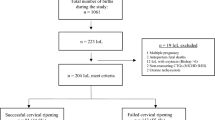Abstract
OBJECTIVE: Prospectively validate an antenatal bacterial vaginosis (BV) risk score at two public health department obstetrics clinics.
STUDY DESIGN: Women (n=409) entering prenatal care received a BV risk score (range 0 to 16) at their first visit and at 24 to 28 weeks' gestation. BV was measured with Gram-stained vaginal smears. Normal discharge was used as a surrogate for being asymptomatic.
RESULTS: Approximately half of the women scored ≥3 at each assessment. In total 29% had true BV at the first assessment (13% at the second assessment). The BV risk score (≥3) had 91% sensitivity and 63% specificity, and the BV risk score (≥5) had 88% sensitivity and 76% specificity. Among true cases, 42% were asymptomatic, of which 77% had risk scores ≥3. All symptomatic BV cases had risk scores ≥3.
CONCLUSION: In practice, the risk score identified both asymptomatic and symptomatic cases. Asymptomatic women are of particular interest because they are not screened for BV under current practice guidelines.
This is a preview of subscription content, access via your institution
Access options
Subscribe to this journal
Receive 12 print issues and online access
$259.00 per year
only $21.58 per issue
Buy this article
- Purchase on Springer Link
- Instant access to full article PDF
Prices may be subject to local taxes which are calculated during checkout



Similar content being viewed by others
References
Hill GB . The microbiology of bacterial vaginosis. Am J Obstet Gynecol 1993;169:450–454.
McGregor JA, French JI . Bacterial vaginosis in pregnancy. Obstet Gynecol Surv 2000;55(5 Suppl 1):S1–S19.
Amsel R, Totten PA, Spiegel CA, Chen KC, Eschenbach D, Holmes KK . Nonspecific vaginitis. Diagnostic criteria and microbial and epidemiologic associations. Am J Med 1983;74(1):14–22.
Eschenbach D, Hillier SL, Critchlow C, Stevens C, DeRouen T, Holmes KK . Diagnosis and clinical manifestations of bacterial vaginosis. Am J Obstet Gynecol 1988;158:819–828.
Nelson D, Macones G . Bacterial vaginosis in pregnancy: current findings and future directions. Epidemiol Rev 2002;24(2):102–108.
Carey JC, Klebanoff MA, Hauth JC, et al. Metronidazole to prevent preterm delivery in pregnant women with asymptomatic bacterial vaginosis. National Institute of Child Health and Human Development Network of Maternal-Fetal Medicine Units. [comment][summary for patients in Can Fam Physician. 2002;48:891-3; PMID: 12138871]. N Eng J Med 2000;342(8):534–540.
Taha TE, Hoover DR, Dallabetta GA, et al. Bacterial vaginosis and disturbances of vaginal flora: association with increased acquisition of HIV. AIDS 1998;12(13):1699–1706.
Mastrobattista JM, Bishop KD, Newton ER . Wet smear compared with gram stain diagnosis of bacterial vaginosis in asymptomatic pregnant women. [comment]. Obstet Gynecol 2000;96(4):504–506.
Nugent RPKM, Hillier SL . Reliability of diagnosing bacterial vaginosis is improved by a standardized method of Gram stain interpretation. J Clin Microbiol 1991;29(2):297–301.
Pastore LM, Thorp Jr. JM, Royce RA, Savitz DA, Jackson TP . Risk score for antenatal bacterial vaginosis: BV PIN points. J Perinatol 2002;22(2):125–132.
Sackett DL, Haynes RB, Guyatt GH, Tugwell P . Clinical Epidemiology: A Basic Science for Clinical Medicine. 2nd ed. Boston: Little, Brown & Company, 1991.
Hay P, Morgan D, Ison C, et al. A longitudinal study of bacterial vaginosis during pregnancy. Br J Obstet Gynaecol 1994;101(12):1048–1053.
Berg AO . Screening for bacterial vaginosis in pregnancy. Recommendations and rationale. Am J Prev Med 2001;20(3 Suppl):59–61.
Leitich H, Bodner-Adler B, Brumbauer M, Kaider A, Egarter C, Husslein P . Bacterial vaginosis as a risk factor for preterm delivery: a meta-analysis. Am J Obstet Gynecol 2003;189(1):137–147.
Krohn M, Hillier SL, Nugent RP . The genital flora of women with intraamniotic infection. J Infect Dis 1995;171:1475–1480.
Watts DH, Krohn M, Hillier SL . Bacterial vaginosis as a risk factor for postcesarean endometritis. Obstet Gynecol 1990;75:52–58.
Koumans EH, Kendrick JS . Preventing adverse sequelae of bacterial vaginosis: a public health program and research agenda. Sex Transm Dis 2001;28(5):292–297.
Acknowledgements
We thank Elizabeth Bumgarner for her research assistance, Mary Otterness for her programming assistance, Tara Patton for medical record abstraction, and Dr Dana Redick for her helpful suggestions on the manuscript. Gram staining was provided gratis by LabCorp of America in Burlington, NC.
Author information
Authors and Affiliations
Additional information
This work was financially supported by the North Carolina Health Start Foundation.
Rights and permissions
About this article
Cite this article
Pastore, L., King, T., Dawson, I. et al. Prospective Validation of a Perinatal Bacterial Vaginosis Screening Risk Score. J Perinatol 24, 735–742 (2004). https://doi.org/10.1038/sj.jp.7211179
Published:
Issue Date:
DOI: https://doi.org/10.1038/sj.jp.7211179
This article is cited by
-
Maternal antenatal profile and immediate neonatal outcome in VLBW and ELBW babies
The Indian Journal of Pediatrics (2006)



